
Way down here in the fictional land of Australia (and New Zealand, I guess), far from the advantages of living in the United States, we have Madman Entertainment. Madman is the primary handler of anime licensing and distribution, the streaming service AnimeLab, and hosting Madman Anime Festival.
Thanks to Madman sending me a box of their new releases for this month, I’ll be doing a short overview of site rankings, similar anime, some of my own thoughts, and how to find out more about each item. Comments have been kept as spoiler-free as possible!
You can check out all of these releases and more here 👉 Madman Anime Release Schedule (September 2020)
*Takoyaki and box not included
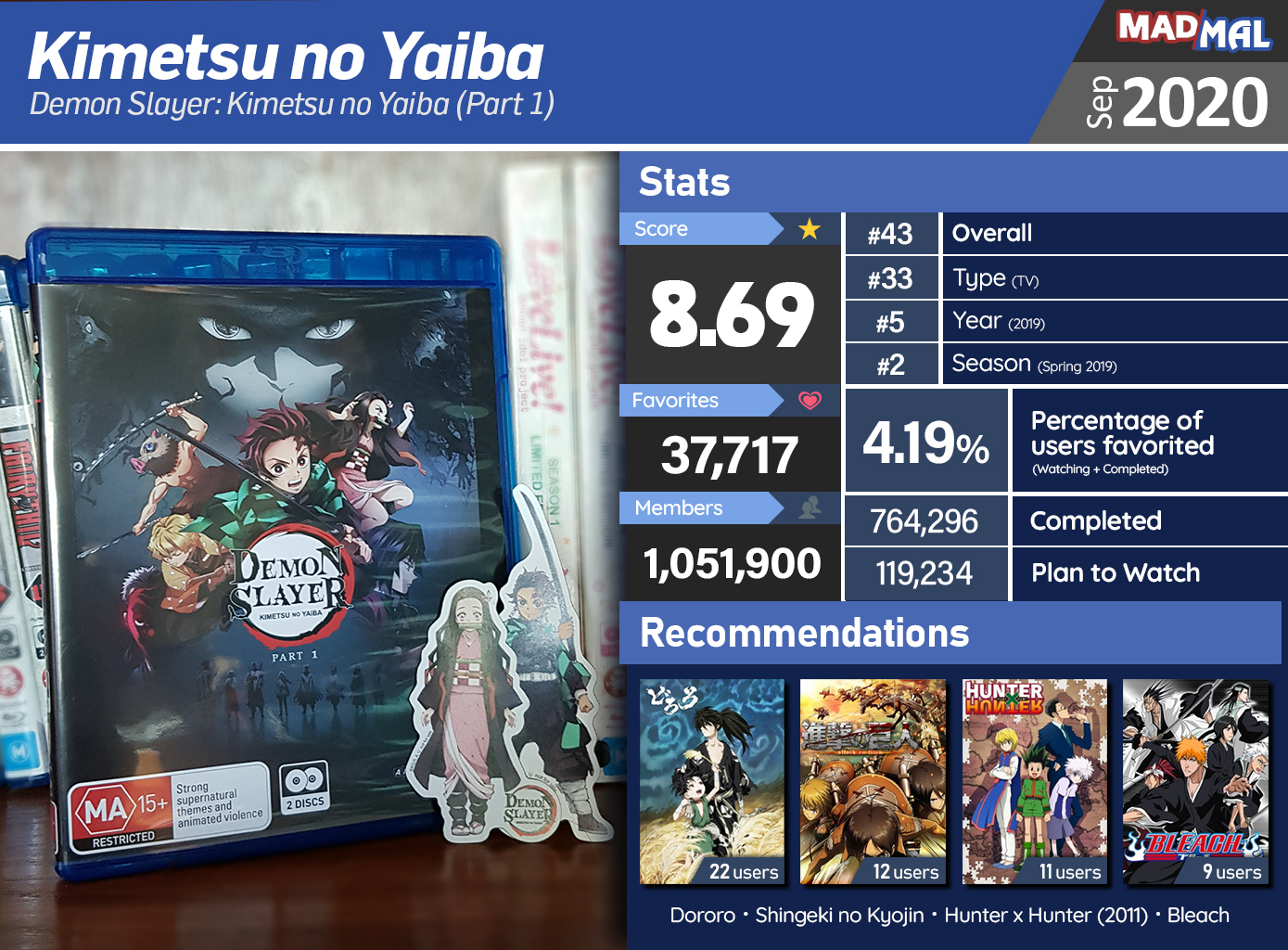
Synopsis
Ever since the death of his father, the burden of supporting the family has fallen upon Tanjirou Kamado’s shoulders. Though living impoverished on a remote mountain, the Kamado family are able to enjoy a relatively peaceful and happy life. One day, Tanjirou decides to go down to the local village to make a little money selling charcoal. On his way back, night falls, forcing Tanjirou to take shelter in the house of a strange man, who warns him of the existence of flesh-eating demons that lurk in the woods at night.
When he finally arrives back home the next day, he is met with a horrifying sight—his whole family has been slaughtered. Worse still, the sole survivor is his sister Nezuko, who has been turned into a bloodthirsty demon. Consumed by rage and hatred, Tanjirou swears to avenge his family and stay by his only remaining sibling. Alongside the mysterious group calling themselves the Demon Slayer Corps, Tanjirou will do whatever it takes to slay the demons and protect the remnants of his beloved sister’s humanity.
[Written by MAL Rewrite]
Comments
Analysis
Kimetsu no Yaiba is a big deal. Hot take, I know.
Every anime but one in this month’s collection premiered in mid-2019, but Kimetsu no Yaiba outstrips the rest in overall popularity by several orders of magnitude. And the achievements don’t stop there: it’s the fastest anime ever to hit 1,000,000 members by a matter of months, one of four Weekly Shounen Jump franchises in the top 50 anime of all time, and the second highest-rated debut of 2019 behind only Vinland Saga. And before conventions were ultimately deemed unwise, I witnessed Kimetsu no Yaiba cosplayers outnumber the class of Boku no Hero Academia—even when the show was still in the middle of airing.
Kimetsu no Yaiba initially debuted with a score of 8.28 and climbed to 8.49 by the end of its first cour of 13 episodes (what’s included in this set). Episode 19 is frequently purported as the whole reason for Kimetsu no Yaiba‘s success (you can read more about its impact in my analysis here), but it was already doing impressive figures long before—episode 4, Tanjirou’s defeat of the Hand Demon at the Final Selection, had the second-highest score increase of the series with a remarkable +0.08.
Opinion
When the shounen formula is tried, tested, and true, what else can you do?
Setting aside stellar production quality, the primary subject of dissent, Kimetsu no Yaiba is your standard shounen at its core—it doesn’t subvert or evolve tropes, but there’s enough of a twist in its presentation that deservedly sets it apart. There’s an early training arc, but it doesn’t consume the story or perform a miracle development; there’s a overly kind main character, but his compassionate nature to humans and demons alike is accentuated by his loss; we trail our way through a routine series of monsters, but each deftly delivers its own story steeped in themes of mortality and desire. And of course, the sharply animated fight scenes are a step above the rest.
I don’t agree with the take that the series is only upheld by its art and animation, but it’s undeniable that Kimetsu no Yaiba would not be what it is without ufotable. More than just pretty visuals, their key achievement is amping up Kimetsu no Yaiba‘s strengths, persuasively papering over its narrative weaknesses. The detailed environments, indoors and outdoors, combined with Yuki Kajiura’s brand of traditional music pushes Kimetsu no Yaiba‘s unique Taisho era setting to the foreground of its grim, shifting world.
A good shounen’s heart is in its central cast, and I think this is where Kimetsu no Yaiba stumbles as an otherwise noteworthy shounen. The designs are stimulating yet subtle, not to mention superb as cosplay material (a quality of growing importance, especially for shounen), but I don’t feel the same charismatic warmth I’ve come to expect watching Hunter x Hunter (2011) or Haikyuu!!. The first half focuses on the compelling familial bond between Tanjirou and Nezuko before Timon and Pumbaa Zenitsu and Inosuke scream their way onto the scene right just before the end—I love Inosuke’s chaotic energy and mischief, but gratifying group cohesion and individual relations (like we get with Gon and Killua or Hinata and Kageyama) are regrettably non-existent.
To reiterate: Kimetsu no Yaiba is a big deal. Not just for its technical marvels, but for how it’s defining a fresh generation of anime fans alongside Boku no Hero Academia. It still has its inherent genre flaws, but I’m excited to follow up with the arguably superior second half when it eventually releases on Blu-ray.
➡️ Find out more about Kimetsu no Yaiba
➡️ Check out Demon Slayer – Kimetsu No Yaiba – Part 1 (Eps 1-13) (Blu-Ray)
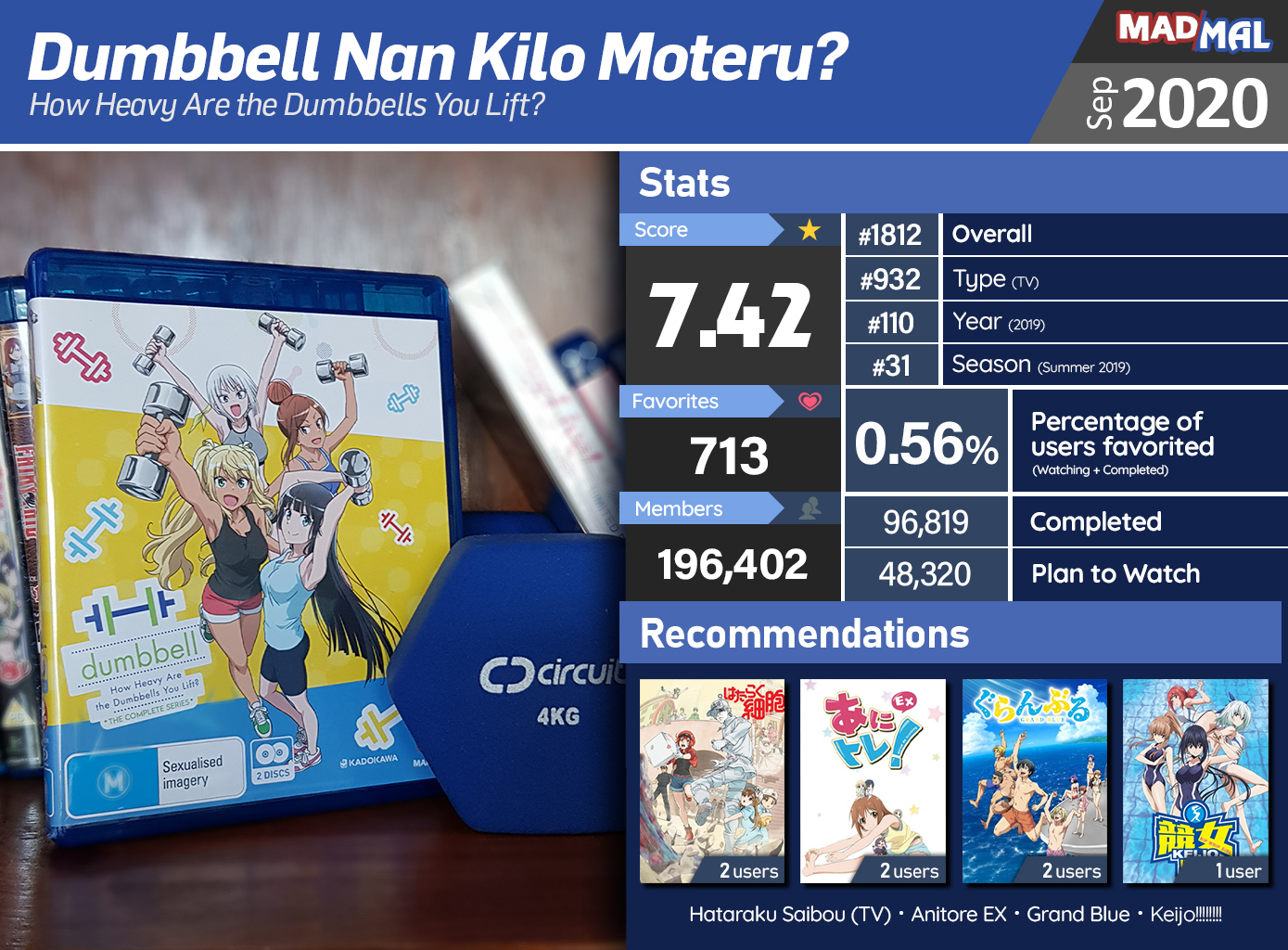
Synopsis
During a regular after-school grub crawl, gluttonous high schooler Hibiki Sakura is confronted about her ever-expanding waistline by her best friend, Ayaka Uehara. With her attempts at solitary exercise failing miserably, Hibiki decides to join the newly opened Silverman Gym. At her orientation, Hibiki runs into student council president and school idol Akemi Souryuuin.
However, it soon turns out that Hibiki is in for a lot more than she bargained for. Not only is Silverman Gym full of world-renowned bodybuilders and athletes, but to make matters worse, Akemi turns out to be a total muscle fetishist! Grossed out by the scene unfolding before her eyes, Hibiki begins to leave, only to be stopped by trainer Naruzou Machio. Completely enthralled with her newfound Prince Charming, Hibiki signs up as a gym member. Now, as a result of her spur-of-the-moment decision, Hibiki must adapt to her new lifestyle.
[Written by MAL Rewrite]
Comments
Analysis
A score of 7.42 pales in comparison to the other powerhouses of 2019 in this collection, but for an ecchi-focused comedy, it’s distinctly above average. Studio Doga Kobo has a reputation for cute and comfort, thanks to the success of productions like Gekkan Shoujo Nozaki-kun, Sewayaki Kitsune no Senko-san, and New Game!. Dumbbell Nan Kilo Moteru?, which currently ranks as their #14 anime of all time and their 10th most popular after a year, was their first ecchi series in over a decade, and they really delivered.
Opinion
CGDGT: Cute Girls Doing Gym Things
Dumbbell Nan Kilo Moteru? is rare show rich in both entertainment and practical value. There’s zero shame here, so I’m going to be 100% honest: this was the first time, and perhaps the only time, I anticipated an ecchi comedy purely for the ecchi. Heads, shoulders, knees, and toes—no muscle is safe from the camera’s leering gaze. Pulling barbells into busts, suggestive stretches… the list goes on. Hibiki capably emulates the experience of a first-timer, accompanied by fitness nuts, reluctant participants, and the ever-poised and posed Machio. On the flip side of the genre, Dumbbell‘s comedy relies on over-the-top, JoJo-like reaction faces and the sores of its characters. The hyper-focus on hyper-muscular men is amusing at first, but it can take you out of the zone if you’re primarily in it for the ecchi, especially since the humour burns itself out by the end without enough variety. But as I said before, there’s more to this anime than just entertainment.
I joked earlier this year that there should be an OVA for home workouts, but Dumbbell actually does an effective job of that already. It’s a fun primer on all manner of topics from body part terminology to calorie numbers for specific cuts of meat; it even references research by the University of Zagreb—yes, I checked and it’s real. Even on a rewatch, I thought to myself again, “maybe I should give this gym thing a go”—but alas, the timing is inconvenient, so the majority of in-episode lessons focused on gym equipment feel fruitless. But Dumbbell demonstrates you can still make the best of every situation for exercise. When sharks take a bite out of the obligatory beach episode, Akemi suggests burpees on the sand (an exercise that’s aided by “unstable ground”); every end-credits scene summarises the episode’s lessons with an everyday setting using household items like two-liter water bottles and chairs, which you can easily stand up to do so you can be productive while binging this anime for the whole day. There’s even a counter to follow for each one, so following along is the intention. Anitore EX! provides a similar service, but the gaze of that show is… a little bit more problematic.
But if Dumbbell‘s adrenalising opening theme alone isn’t enough to convince you, then I don’t know what is.
➡️ Find out more about Dumbbell Nan Kilo Moteru?
➡️ Check out How Heavy Are the Dumbbells You Lift? Complete Series (Blu-Ray)
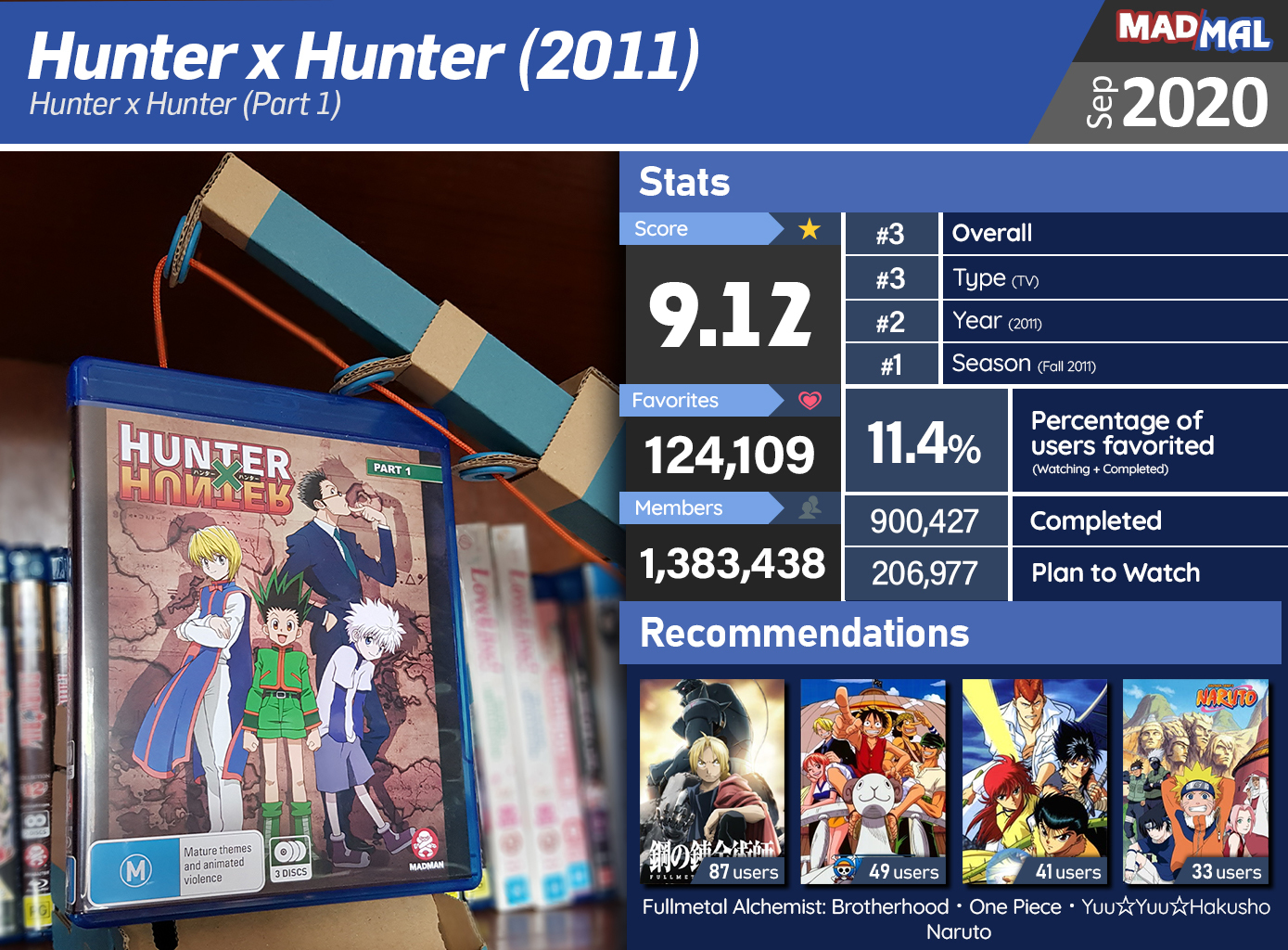
Synopsis
Hunter x Hunter is set in a world where Hunters exist to perform all manner of dangerous tasks like capturing criminals and bravely searching for lost treasures in uncharted territories. Twelve-year-old Gon Freecss is determined to become the best Hunter possible in hopes of finding his father, who was a Hunter himself and had long ago abandoned his young son. However, Gon soon realizes the path to achieving his goals is far more challenging than he could have ever imagined.
Along the way to becoming an official Hunter, Gon befriends the lively doctor-in-training Leorio, vengeful Kurapika, and rebellious ex-assassin Killua. To attain their own goals and desires, together the four of them take the Hunter Exam, notorious for its low success rate and high probability of death. Throughout their journey, Gon and his friends embark on an adventure that puts them through many hardships and struggles. They will meet a plethora of monsters, creatures, and characters—all while learning what being a Hunter truly means.
[Written by MAL Rewrite]
Comments
Analysis
To MAL and myself, Hunter x Hunter (2011) is like an old friend. It rests comfortably near the peak of our Top Anime chart, one of only 11 anime with a score above 9.00, and you don’t have to scroll far to find it on Most Popular and Most Favorited either. My deep dive into the best anime of last decade returned more spectacular results. Hunter x Hunter (2011) came in at #25 overall for Completed members (669,370), even with an imposing 148 episodes. To put that in perspective, the next highest anime with more than two cours was Fairy Tail (2014) with less than half the members at #116. That commitment speaks volumes.
Though it’s been available on Crunchyroll for many years, it was advertised as AnimeLab’s “#1 Requested Show” when it was added to their catalogue earlier this year. And now, alongside it, comes the first of many Blu-ray volumes to come.
Opinion
“The joy of discovering something that tastes delicious… I hope you got a little taste of it.” – Menchi
Way back in the more optimistic summer of 2016, a young Shy (if only that was my actual name) had an idea. To kick off the new year, he was going to take on a challenge to expand his anime-watching horizons—watch one episode of three long-running anime each day: Katekyo Hitman Reborn!, Gintama, and Hunter x Hunter (2011). And, well, this lasted for roughly 1-2 weeks.
I threw Katekyo Hitman Reborn! and Gintama on the eternal back burner, but Hunter x Hunter (2011) is something I’ve sporadically chipped away at for nearly five years now. It’s not that I don’t enjoy it or I think it’s seriously overrated—it’s still imbued with infectious fun even in its darker moments, and it deserves all the praise it’s received. I even took a sizeable stab at it this year, bringing my progress up to 89 episodes. But my irregular viewing pattern, neither a dedicated binge nor a weekly event, took me too out of the zone to fully appreciate the series. Picking it up again after a year at the conclusion of Yorknew City and right into Greed Island was… not enlivening, to say the least, even after I proceeded into what is widely regarded as the best arc of Hunter x Hunter (2011). I’ve long desired an excuse to reset, and thanks to Madman’s Blu-ray release of episodes 1-26, I’ve hooked that second chance.
The first arc of Hunter x Hunter (2011) offers an interesting retrospective for me. Like Fullmetal Alchemist: Brotherhood and One Piece, it offers a grand world-spanning adventure that begins in the humblest of places and characters. Hunter x Hunter (2011) does more to earnestly sell its cast in three episodes than many series do in their entirety, and I instantly fell in love with them again. But at the same time, I found that I also longed for those smaller moments, as the proceeding arcs get grander and grander in scale, splitting the party and upping the stakes. The diverse ambitions of the hunting world that the Gourmet Hunters exemplify during the Hunter Exam are a significant part of that, and something I desire more of. That’s the kind of world that Hunter x Hunter (2011) builds from the get-go.
One-cour Blu-ray sets usually run for ~A$60-70 upon release, but Hunter x Hunter Part 1 includes double the episodes for just $15 more, so it’s a big tick in the big ol’ Value box for me. Plus, Leorio is the only member of the quartet without his own disc, so it’s perfectly crafted for fans of the show.
Note: My older Blu-ray player was unable to run this set (every other item worked fine), so beware of possible compatability issues.
➡️ Find out more about Hunter x Hunter (2011)
➡️ Check out Hunter X Hunter Part 1 (Eps 1-26) (Blu-Ray)
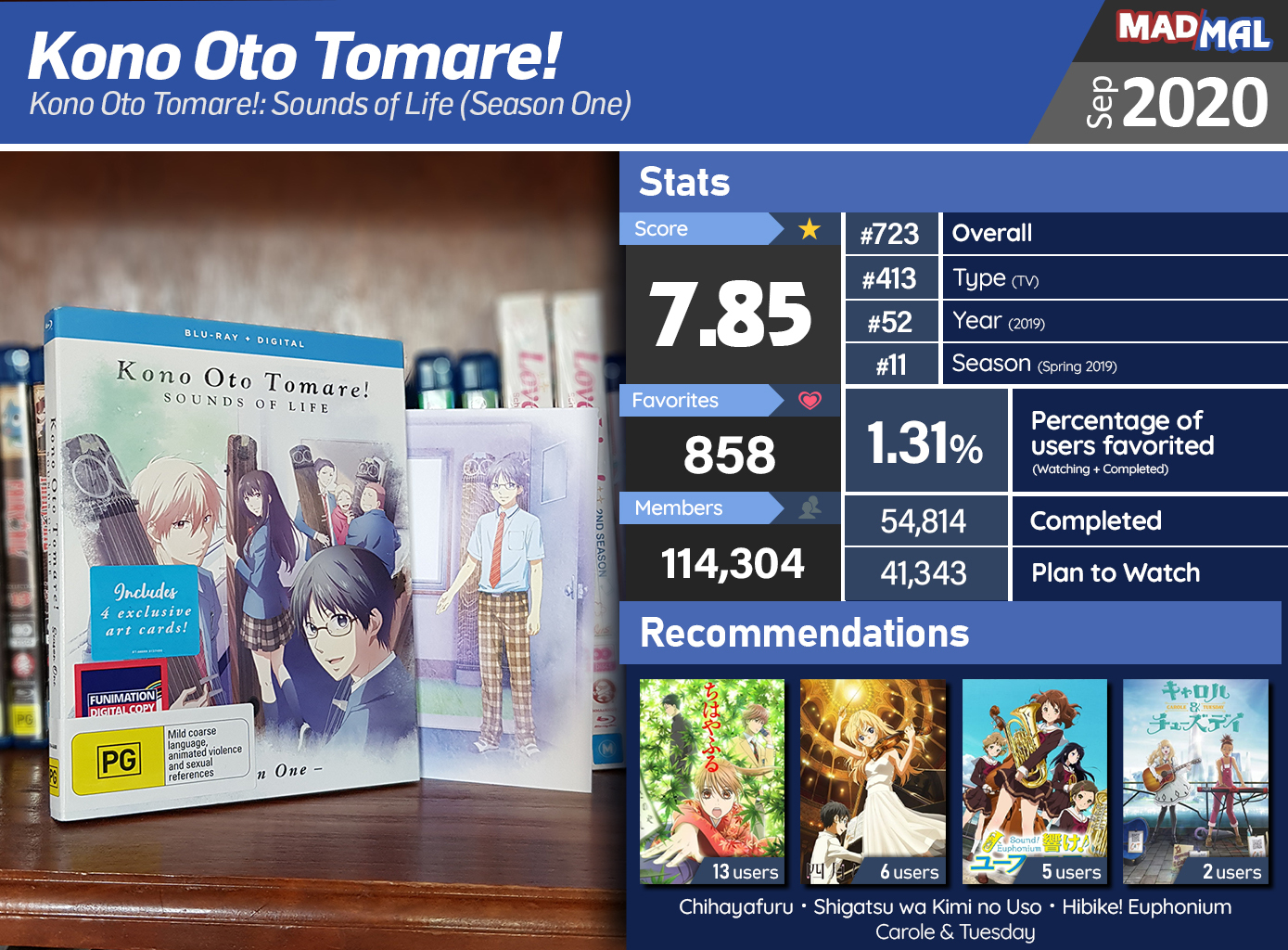
Synopsis
Gen Kudou, a koto maker, believes that his delinquent grandson Chika would never understand the profoundness of the traditional musical instrument. In an attempt to make up for his naivety and understand the words of his late grandfather, Chika tries to join the Tokise High School Koto Club.
Even though the club is in dire need of members, new club president Takezou Kurata is unwilling to easily accept Chika’s application due to his bad reputation. Nonetheless, after seeing Chika’s seriousness and enthusiasm, Takezou allows the problem child to join, along with koto prodigy Satowa Houzuki and three of Chika’s energetic friends. Kono Oto Tomare! follows the merry band of musicians as they aspire to play at the national competition.
[Written by MAL Rewrite]
Comments
Analysis
Kono Oto Tomare! failed to compete with Shinichiro Watanabe’s latest work at studio Bones in the Music category for Spring 2019, ultimately overshadowed in both score and popularity. But Kono Oto Tomare! still trumped expectations, rising in score almost every week from a humble 7.38, contrasting Carole & Tuesday‘s steady diminuendo.
Season 2 in Fall 2019 then made a remarkable jump to a current score of 8.44, taking the #2 spot for the season behind Chihayafuru 3.
Opinion
Out of the six anime in this collection, this is the only one I watched for the first time. As head of the social media team, my anime-watching lifestyle is at the mercy of seasonals and prioritising high-value content. Even when I spread myself thin across almost all airing shows, a few shows like Kono Oto Tomare! fall through the cracks. And I really missed out.
Kono Oto Tomare! is more of an unorthodox sports anime in its story beats than a typical music-themed show (hence all the extra comparisons to Chihayafuru over Shigatsu wa Kimi no Uso and Hibike! Euphonium). It follows a high school club on the verge of disbandment as they aim high for nationals, even though their gradually expanding group of members are completely inexperienced… but it’s their raw determination that propels them forward and upward.
Some of the challenges the club faces in the first season, a grouchy vice-principal with an ultimatum and a bored “popular girl” with a penchant for emotional manipulation, were almost laughable, but they resolved themselves in surprisingly positive ways. The vice-principal is, in effect, killed with kindness for how he motivated the koto club, and the bored girl realises her mistakes and contributes her past expertise. One of my earliest critiques as I was watching was the lack of actual koto music, but that drought makes the club’s first performance in episode 5 all the more impactful.
For anime with this kind of foreign component at its core, I have an irregular priority—what I can learn about the subject from the show. This goes for actual sports anime like Yuri!!! on Ice, and other tradition-themed works like Shouwa Genroku Rakugo Shinjuu. We get a brief understanding of how a koto is constructed, along with frequent flashes of koto’s unique musical notation and , but not much else. The koto takes on a more metaphorical connotation—the laborious weight of the instrument and the way they’re played in perfect sync represent the collective overcoming of their burdens and trauma. Kono Oto Tomare! is all about giving people a chance to grow and improve, and music is the perfect narrative vehicle for that.
Takezou, the club president, is quickly sidelined for Chika, an ex-juvenile sentenced for a crime he didn’t commit, and Satowa, a tortured genius with an icy personality that melts. The occasional bickering and totally-not-romantic interactions between these two steal the show, as they motivate and willingly accept help from the other. Three enthusiastic delinquents who admire Chika make up the club’s ensemble, and I can just about remember one of their names.
The biggest letdown is awkwardly drawn art at times, particularly in facial expressions, even with fewer transitions and low scene variety (some audience shots are repeated). That being said, actual performances hold up fairly well, displaying the meticulous finger movements required for playing the koto and visually capturing the atmosphere of each piece.
Lastly, I have to mention that this Blu-ray has the nicest art cards I’ve ever gotten (example pictured above). They usually come in a type of a matte photo print, but Kono Oto Tomare! Sounds of Life Season One‘s art cards are a canvas-like material with pseudo-watercolour, matching the show’s eyecatchers.
➡️ Find out more about Kono Oto Tomare!
➡️ Check out Kono Oto Tomare! Sounds of Life Season One (Blu-Ray)
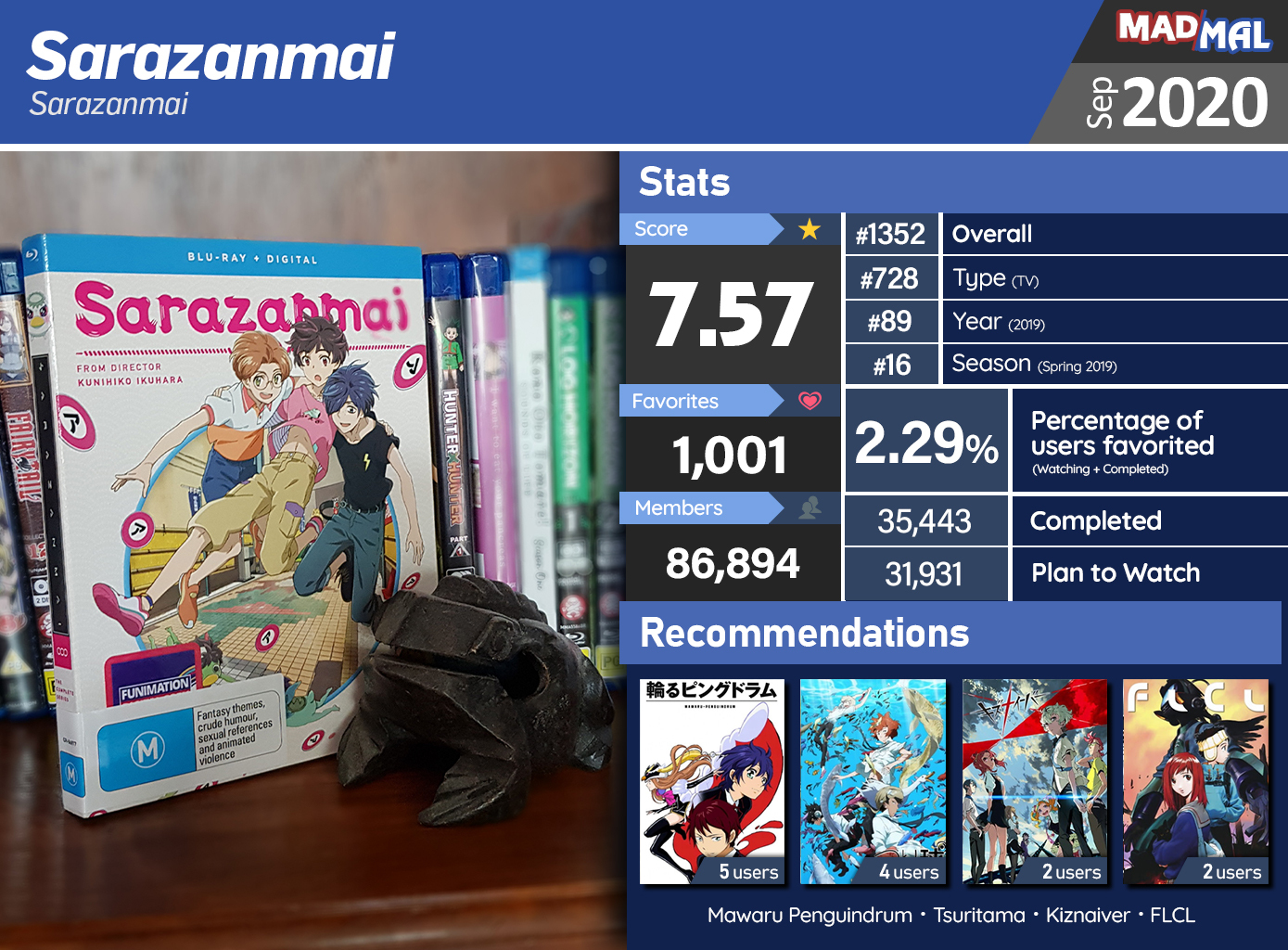
Synopsis
After the noble Kappa Kingdom falls to the Otter Empire, the Kappa prince Keppi loses much of his power and becomes helpless against the unseen Kapa-zombies. These zombies plague the world, and are the creations of the Otters and manifestations of people’s deepest desires. With no other choice, Keppi must rely on three young boys: Kazuki Yasaka, who must carry a box with him wherever he goes; Enta Jinnai, Kazuki’s childhood friend; and Tooi Kuji, a delinquent and a school truant.
By having the mythical organ called a shirikodama removed from them, the boys are able to become Kappa themselves and fight the Kapa-zombies. However, to defeat them, the boys must connect with each other via their minds, bodies, and—most importantly—secrets. As the Kappa Kingdom relies on these boys, they must reveal themselves as they have never done before, all the while learning that connections are fragile and truly precious things.
[Written by MAL Rewrite]
Comments
Analysis
Kunihiko Ikuhara is the 139th most favorited person of all time and the 12th most favorited director. His first directorial work in four years, the provocatively packed Sarazanmai, scored significantly lower than Mawaru Penguindrum (7.99) and Shoujo Kakumei Utena (8.19), but much higher than Yuri Kuma Arashi (7.09).
Though it was somewhat skewed by recency at the time of recording, Sarazanmai was #9 for the year and #151 for the whole decade in favorites %.
Opinion
That synopsis really takes the cake kappa, huh.
I watched Sarazanamai back when it was airing in Spring 2019, but I was unable to give it the focus it demanded at the time. It’s not that it didn’t grab me immediately (in fact, quite the opposite), Even after a rewatch, I’m still mystified by Ikuhara’s messaging, but I continue to appreciate his bold and unrelenting style in spite of underlying and overrarching flaws. I can’t comment on how Sarazanmai fits into Ikuhara’s other works since I’ve only seen Yuri Kuma Arashi, which holds back my understanding of his intentions, but their correlation is the kind of eccentricity and innovative creativity in anime I seek out. The more knowledgeable voices on Sarazanmai‘s reviews page should be able to help there.
It isn’t too difficult to grasp the initial theme of the show: the first episode opens with a monologue how the world is filled with “connections”—connections of blood, connections of the city, connections of desires, etc. All seems relatively normal… until the main trio is gobbled up and anally ejected as newborn kappas, which is a (repeated) scene not for the faint of stomach. One continually questions the necessity of this visually “gripping” moment and many others throughout the show, whether there is some thematic meaning or its done for the sake of style and shock value. But beneath the outer layer of eyecatching goo, there’s a gooey tale of adolescence being told (with a notable hint of LGBT themes), if you’re able to pick it apart before the series rushes onwards.
Anything I write here feels inadequate in describing the kind of anime Sarazanmai is, so I’ll leave it at that—it’s something I strongly recommend as a first episode than a whole series. It’s a love-hate scenario one way or another, and the first episode contains all you need to make that judgment. Even after a second viewing, it’s still a series I’d like to come back to after checking out Ikuhara’s other directorial works, so that I can perhaps get just an inkling of how this man’s mind works.
➡️ Find out more about Sarazanmai
➡️ Check out Sarazanmai Complete Series (Blu-Ray)
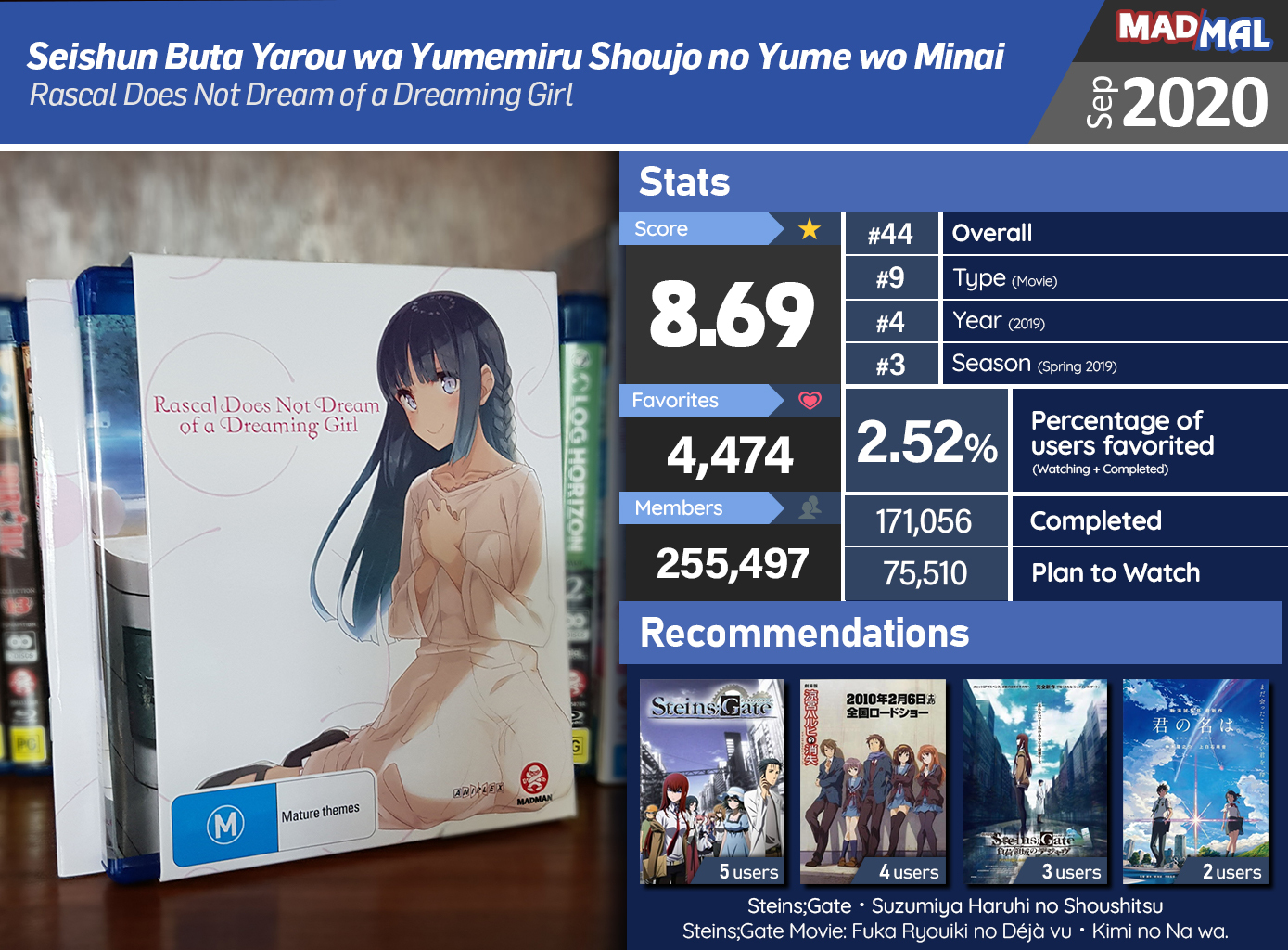
Synopsis
Six months ago, Sakuta Azusagawa had a chance encounter with a bunny girl in a library. Ever since then, he’s been blissfully happy with his girlfriend: Mai Sakurajima, that same bunny girl. However, the reappearance of his mysterious first crush, the now-adult Shouko Makinohara, adds a new complication to his relationship with Mai. To make matters worse, he then encounters a middle school Shouko in the hospital, suffering from a grave illness. Mysteriously, his old scars begin throbbing whenever he’s near her.
With Shouko’s bizarre situation somehow revolving around him, Sakuta will need to come to terms with his own conflicting feelings, for better or worse. With a girl’s life in his hands, just what can he do?
[Written by MAL Rewrite]
Comments
Analysis
Seishun Buta Yarou wa Bunny Girl Senpai no Yume wo Minai (Rascal Does Not Dream of Bunny Girl Senpai) was undoubtedly one of the biggest surprise hits of 2018 when it premiered in a packed Fall season. It was only #7 with around 30,000 members at the time, but it has since climbed to #1 for Fall 2018 with over 100,000 more members than Tensei shitara Slime Datta Ken and Goblin Slayer, not to mention #101 in overall site popularity.
The theatrical follow-up, Seishun Buta Yarou wa Yumemiru Shoujo no Yume wo Minai (Rascal Does Not Dream of a Dreaming Girl), now ranks as one of the best anime movies of all time according to nearly 140,000 users.
Opinion
Before I received this collection (and a few things I bought for myself around the same time), I hadn’t bought an anime Blu-ray in I’d say well over a year. In the modern age of Everything Is On A Streaming Service, I tend to put more of my limited disposable income toward manga. But when you throw away the pirate hat for good, the scope of anime movies you can watch within that sphere becomes brutally narrow. As such, I tend to get films on Blu-ray far more often than TV shows, especially since they hold more rewatch value at a lower price.
For that reason, a movie sequel that’s essential for rounding out what the series set up is a frustrating feature, but Seishun Buta Yarou wa Yumemiru Shoujo no Yume wo Minai decidedly proves its worth. I was at least fortunate to see this one in theatres, which is more than I can reasonably hope for with the Given movie, so… sigh
So anyway, after all that talk about how I treat anime films… I felt a little underwhelmed†.
†On the rewatch
Though it wasn’t a conceptually or artistically groundbreaking dramady, I enjoyed Seishun Buta Yarou wa Bunny Girl Senpai no Yume wo Minai‘s fun character dynamics, underlying themes of youth struggles, and introduction to the peggies like most other people. Despite the poster and title, Seishun Buta Yarou wa Yumemiru Shoujo no Yume wo Minai is centered on the main characters’ relationship and Sakuta’s stubborn refusal to change his self-sacrificial ways. There are some brutal tearjerker moments that I won’t spoil, but I have to admit that they didn’t hit anywhere near as strongly as the first viewing, whereas I rewatch my Blu-ray copies of Kimi no Na wa. and Koe no Katachi semi-regularly and still get emotional over them.
Seishun Buta Yarou wa Yumemiru Shoujo no Yume wo Minai is a satisfying movie that adequately rounds out the remaining plot threads and gives its ensemble one last hurrah, but its instrinsic attachment to a separate anime diminishes the value for me, especially since it requires the full leadup to properly rewatch—like purchasing a game expansion pass you don’t really need, but you dislike not having the full set for (hi, this is me). However, I doubt this is or will be an issue to most of you.
The special edition I received comes with a booklet featuring character designs and details, visuals, storyboards, credits, and, most amusingly, this character relation map that encapsulates the whole series.
➡️ Find out more about Seishun Buta Yarou wa Yumemiru Shoujo no Yume wo Minai
➡️ Check out Rascal Does Not Dream of a Dreaming Girl (Subtitled Limited Edition) (Blu-Ray)




Leave a comment
You must be logged in to post a comment.